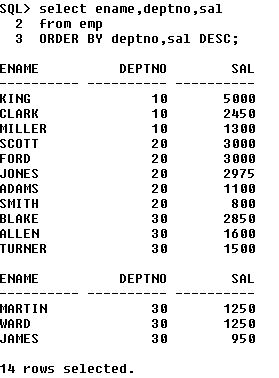- Case-manipulation functions
- LOWER :- Converts alpha character values to lowercase.
- UPPER :- Converts alpha character values to uppercase.
- INITCAP :- Converts alpha character values to uppercase for the first letter of each word.
- Character-manipulation functions
- CONCAT :- Concatenates the first character values to second character value.
- SUBSTR :- Return specified characters from character value.
- LENGTH :- Returns the number of character in the expression.
- INSTR :- Returns the numeric position of a named string.
- LPAD :- Pads the character value right justified to a total width of n.
- RPAD :- Pads the character value left justified to a total width of n.
- TRIM :- Enables you to trim heading or trailing characters from a character string.
- REPLACE :- Searches a text expression for a character string and if found, replaces it with a specified replacement string.
Example:
LOWER
UPPER & INITCAP
CONCAT
SUBSTR
LENGTH
INSTR
LPAD & RPAD
TRIM












